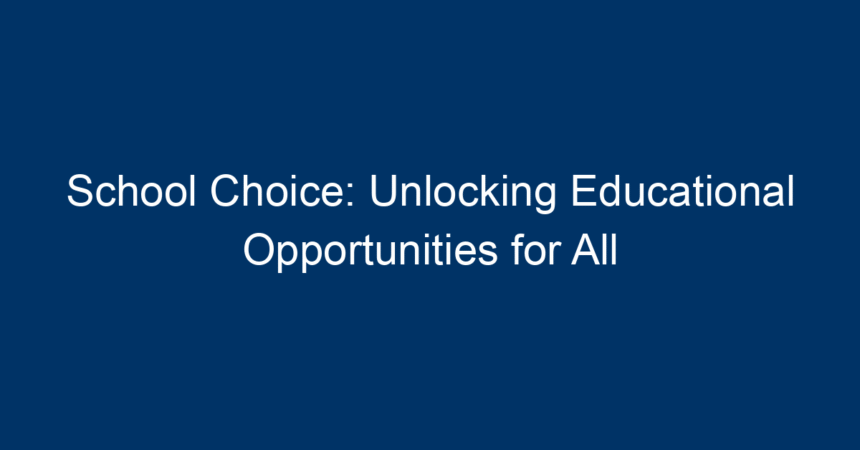In today’s rapidly evolving educational landscape, the term "school choice" has emerged as a guiding principle for many parents, educators, and policymakers. As families seek the best pathways for their children’s education, the school choice movement promises a broader range of options, allowing students to thrive in environments tailored to their individual needs. This article delves deep into the world of school choice, exploring its benefits, challenges, and the transformative power it holds in unlocking educational opportunities for all.
Understanding School Choice
At its core, school choice refers to the policies and practices that enable families to select educational institutions outside their designated public school options. This includes charter schools, magnet schools, private schools, homeschooling, and even online learning platforms. The movement has gained significant traction over recent years, fueled by a growing recognition of the diverse learning needs within our communities.
The Philosophy Behind School Choice
The philosophy of school choice is rooted in the belief that every child deserves access to high-quality education that caters to their unique needs and aspirations. Traditional public school systems often fall short in addressing the diverse backgrounds, abilities, and interests of students. School choice aims to dismantle these barriers, offering families greater autonomy to pursue educational settings that align with their values and requirements.
Benefits of School Choice
1. Tailored Learning Experiences
One of the most significant advantages of school choice is the ability to provide tailored learning experiences. Not all students thrive in a one-size-fits-all environment. By allowing families to explore various educational options, such as specialized curriculums in charter schools or the experiential learning opportunities of private institutions, school choice fosters an environment where students can excel.
2. Enhanced Competition and Innovation
When parents have the authority to choose schools, it fosters a competitive environment among educational institutions. Schools are motivated to improve their services, curricula, and facilities to attract more students. This competition can lead to innovations in teaching practices and a heightened focus on student outcomes, benefiting everyone involved.
3. Increased Parent Engagement
Schools that are part of the school choice system often encourage greater parental involvement. Engaged parents tend to advocate for their children more effectively, ensuring that their voices are heard in educational discussions. This engagement can significantly enhance the school community, resulting in cooperative partnerships between parents, teachers, and administrators.
4. Addressing Educational Inequities
Educational inequities have long plagued many communities, particularly those in low-income or underserved areas. School choice provides an avenue for families to escape failing public schools and seek better educational opportunities. Programs such as vouchers and tax credits can further empower families to access quality education, regardless of socioeconomic status.
Challenges of School Choice
While the benefits of school choice are compelling, it is essential to address the challenges that accompany this movement.
1. Uneven Access
Despite the promise of school choice, access remains uneven. Many families, especially those from low-income backgrounds, may face barriers such as transportation issues or limited knowledge of available options. Ensuring that all families can navigate school choice effectively is crucial to its success.
2. Quality Control
Another significant challenge involves maintaining quality standards across different educational institutions. Without proper oversight, some schools may not meet the educational standards necessary for student success. Policymakers must implement strategies to ensure accountability and excellence across all school types.
3. Funding Disparities
School choice initiatives can lead to funding disparities between public and private institutions. When students leave public schools to enroll in charter or private schools, funding often follows them, which can weaken the resources available to the public schools left behind. This can perpetuate cycles of inadequacy for the very schools that need improvement the most.
Navigating School Choice: Key Considerations for Parents
For families considering school choice, it is essential to navigate the options with care. Here are several key considerations to keep in mind:
1. Research Available Options
Start by researching the various educational options available in your area. This includes public charter schools, magnet schools, private schools, and homeschooling programs. Visit school websites, attend open houses, and engage with current parents and students to gather comprehensive information.
2. Assess Your Child’s Needs
Understanding your child’s specific educational needs and learning style is crucial. Consider their academic strengths, interests, and even social needs. This assessment will guide you toward schools that can provide an environment where they can thrive.
3. Evaluate School Performance
Quality matters. Investigate the performance metrics of the schools you are considering. Look into standardized test scores, graduation rates, and college readiness programs. Accreditation and reviews can also provide insight into the school’s overall reputation.
4. Consider the Curriculum and Extracurricular Offerings
Evaluate the curriculum offered by potential schools. Does it align with your child’s interests? Additionally, assess extracurricular activities and support services, such as tutoring or counseling, that can enrich your child’s educational experience.
5. Visit Schools and Meet with Educators
Nothing beats a firsthand experience. Arrange visits to potential schools and engage with educators, administrative staff, and current students. This interaction can provide valuable insights into the school culture and how well it aligns with your family’s values and needs.
The Future of School Choice
As the conversation around education continues to evolve, school choice will remain a focal point of discussion. Policymakers, educators, and communities are tasked with addressing the challenges while amplifying the benefits. The ultimate goal is to create an educational landscape that provides opportunities for every child, regardless of their background.
Policy Considerations
Advocates suggest that educational policies should focus on transparency, equitable funding, and rigorous accountability measures to ensure that all schools maintain high standards. With thoughtful policymaking, school choice can become a powerful tool for educational reform.
Community Engagement
Communities must work collaboratively to support families in their school choice journeys. Workshops, informational sessions, and support networks can equip parents with the knowledge they need to make informed decisions.
Conclusion: Empowering Families Through School Choice
School choice has the potential to revolutionize the educational experience for countless students and families. By granting parents the autonomy to select the most suitable educational pathways for their children, we can unlock a world of opportunities.
As we move forward, it is vital to address the challenges associated with school choice to ensure equity and quality for all. Engaging with local policymakers, community leaders, and educators can pave the way for a brighter educational future. Together, we can support a system that truly allows every child the chance to thrive—because every child deserves a learning environment tailored to their unique journey.
By embracing the principles of school choice, we take a significant step towards transforming education into a more inclusive, innovative, and empowering experience for all.




